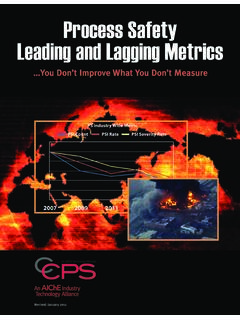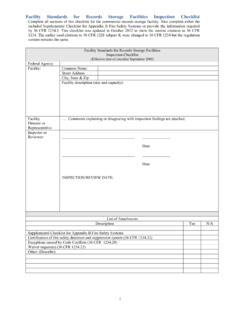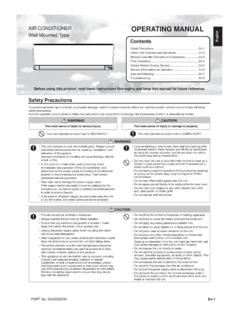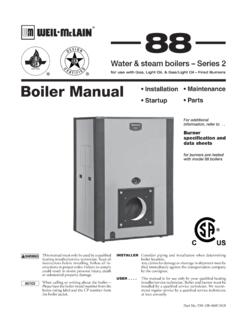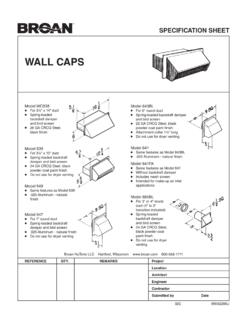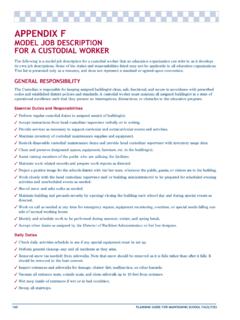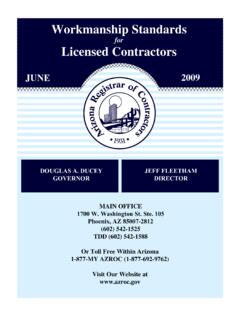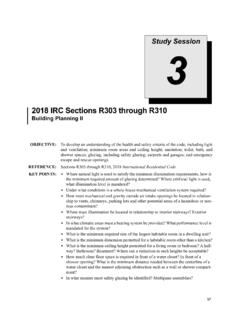Transcription of Process Burners 101 - AIChE
1 CEP August 2013 35 Back to BasicsProcess Burners (1) operate in heaters and furnaces in the refining, petrochemical, and chemical Process industries (CPI). While each of these industries has specific requirements, most Process Burners have a heat release of 1 15 MMBtu/h ( MW), a firebox pressure at the burner of to in. H2O ( to mbar), and an excess air ratio of 10 25%. Although most Process Burners have common operating characteristics, they can be classified in a variety of different ways.
2 Motive force forced draft, natural draft, self- aspirated NOx emission control conventional, low-NOx, ultra-low-NOx flame shape round, flat placement in the firebox freestanding (floor), against the wall (floor), in the side wall, in the roof fuel type gas, oil, combination NOx reduction method fuel staging, air staging fuel/air mixing diffusion, premixing. Most Process Burners have a similar design (Figure 1). In a natural-draft burner, air enters through a muffler, which dampens the noise from the burner.
3 Next, the air control adjusts the amount of air flowing through the burner. The air control is typically a set of louvers or damper blades that can be rotated to partially or completely close the entrance into the plenum. The plenum, or windbox, distributes air to the burner throat and dampens the noise from the firebox. The burner tile is a refractory piece that shapes and stabilizes the flame. One or more burner tips are used to inject the fuel into the air stream. They are connected to the fuel risers, which, in turn, are connected to the fuel manifold.
4 A small pilot burner provides an ignition source for the main and rectangular flames Burners can be classified by their flame shape. The two most common flame shapes are round and rectangular ( , flat). Round flames. Freestanding Burners typically have round flames and are placed in the middle of the firebox with radiant tubes mounted on the firebox walls (Figure 2). This firebox configuration is cost-effective because the amount of tube surface area per unit of firebox volume is high. How-ever, the tubes are heated only from one side.
5 Therefore, this firebox design is restricted to applications where the tubes circumferential heat-flux distribution is not critical. Round flames are also appropriate in applications where horizontal flames are required or where Burners are firing in the down-ward Burners may be classified based on flame shape, emissions, fuel type, and other characteristics. Here s what you need to know to work effectively with a burner manufacturer when selecting a burner for your PlatvoetCharles Baukal, Zink Hamworthy CombustionProcess Burners 101 MufflerDamperPlenum (Windbox)TilePrimary Fuel Gas TipStaged Fuel Gas TipPilot Tipp Figure 1.
6 Air enters a Process burner through the muffler and is distributed into the burner throat via the plenum. Fuel gas tips inject fuel into the air stream. A pilot burner ignites the main continues on next pageCopyright 2013 American Institute of Chemical Engineers ( AIChE )36 August 2013 CEPBack to Basics Rectangular flames. Wall-fired Burners (Figure 3) typi-cally produce a flat or rectangular flame (Figure 4). These Burners heat the firebox refractory wall, which radiates heat toward the tubes located in the center of the firebox.
7 This type of firebox arrangement is more costly to build because the amount of tube surface area per unit of firebox volume is low. However, it does permit much better control of heat flux in the tubes, and is therefore the preferred solution in applications where the flux and temperature profile, both longitudinal and circumferential, are critical, such as coker heaters and steam cracking furnaces. Fluegas alone is a poor radiative emitter because it emits and radiates only at certain wavelengths. A solid wall does not have this restriction and is therefore capable of more-efficient radiant heat transfer.
8 Flat-flame wall-fired Burners rely on the firebox wall to create a certain heating pattern that is compatible with the Process . This relatively simple concept produces good flame patterns and low NOx emissions by optimally distributing (staging) the fuel into the air stream and against the wall. This burner is well suited for applications with low heat release per burner, such as delayed coker heaters. Freestanding flat-flame Burners are also typically used in applications with horizontal tubes and low heat release per burner, such as vacuum and coker heaters.
9 Flat flames are preferred in these Process heaters because they provide better radiant coverage of the tubes than round Burners . This results in a more uniform heating profile and lower fouling rates. In some firebox designs, a combination of round and flat flames is used. In such cases, the flat-flame Burners fire against the wall and the round-flame Burners are arranged between rows of emissions control Burners may be classified based on their nitrogen oxides (NOx) emissions as: conventional, low-NOx, ultra-low-NOx, and next-generation ultra-low-NOx (2).
10 Unfortunately, there are no industry standards for the definition of each of these terms, and their use is at the burner manufacturer s discretion. The manner in which burner designs reduce emis-sions has a significant impact on flame shape and behavior. Conventional Burners are designed with no other criteria than flame shape and stability in mind. Until the mid-1980s, when emission limits became very important, this was the dominant burner style. Emissions of NOx, carbon monox-ide (CO), unburned hydrocarbons, and particulate matter are not considered in the design of this burner.

